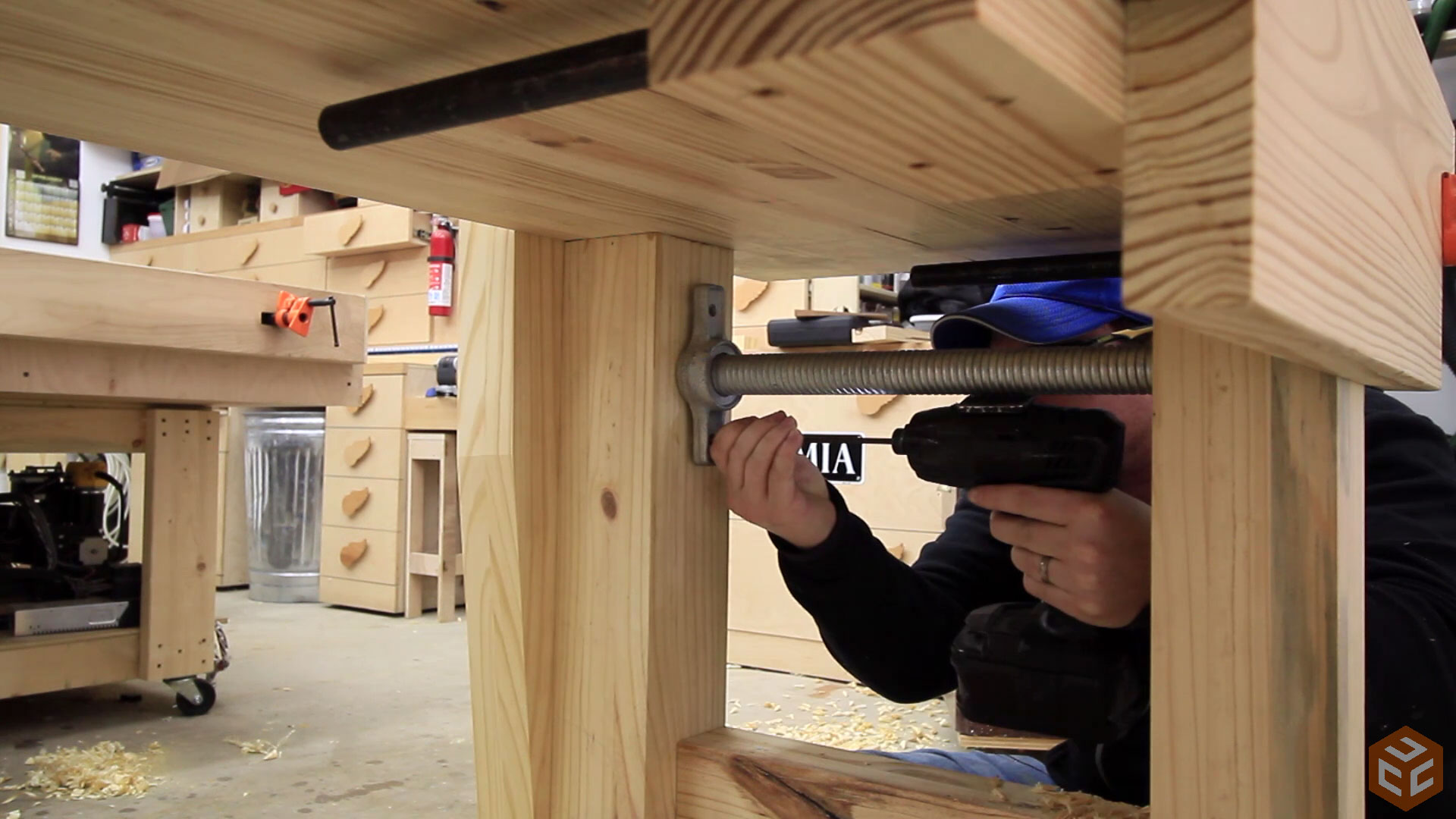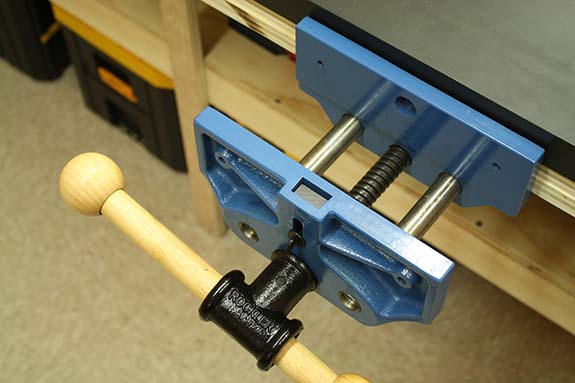
Which side of the bench to mount the vise?
This all presupposes you need to stand with the workbench to your side. If your preference is to stand facing the end of your bench and plane that way, rather than keep the bench to one side of your body or the other, you could mount the vise on the right instead. I like Tim's idea here: put vises all around the bench.
How do you use a twinscrew vise on a bench?
The bench's apron, or a builtup end of the benchtop, serves as the inner jaw. A twinscrew vise has a large opening between the screws for holding wide stock or assembled drawers. Planing long boards held in the jaws can move the bench sideways. Instead, capture the workpiece with bench dogs to take advantage of the bench's full mass.
What is a face vise and how do you use it?
A vise’s location on the bench determines what it’s called. Face vises are connected to the bench’s front; end vises are fastened to the end. If you can only afford one, get a face vise. Right-handers should install a face vise at the bench’s far left front edge and an end vise at the bench’s far right corner.
How do you install a vise without a front vise?
To install without a front vise, just use two small but heavy-duty clamps on either side, making sure to butt the vertical piece right against the edge of your bench. This approach secures the vise in under ten seconds.

Where should I place my vice on a workbench?
Bench vises hold better when you push toward them, with the mass of the bench behind the workpiece. That's why face vises usually are placed on the left end of the bench.
Where do you mount woodworking vise?
0:234:38How to install a Woodworking Vise// Woodworking// Quick Release ViseYouTubeStart of suggested clipEnd of suggested clipLet's go ahead and clamp it to the side of the bench about where you want it to be mounted.MoreLet's go ahead and clamp it to the side of the bench about where you want it to be mounted.
Where should I mount my vice?
0:145:05BENCH VISE - How To Install A Vise - YouTubeYouTubeStart of suggested clipEnd of suggested clipThe side of the bench.MoreThe side of the bench.
Where bench vice is mounted?
VICE POSITION Assuming you're right handed, typical mounting positions would be either toward the left of the front edge of your bench, or the right end of your bench. Carvers will probably find the end position most useful, as will those who clamp wide, flat work like doors and large panels.
Do I need a vise on my workbench?
A workbench is only a success if it can keep itself still and provide means to hold your work. A woodworking vice is not an essential feature of this. Typically though we can expect to see two vices on a workbench today. One will be installed on the front of the bench, towards the left.
How do you fix a vice to a workbench?
0:252:11How to Fix a Vice on a Workbench | Woodworking - YouTubeYouTubeStart of suggested clipEnd of suggested clipMake sure the handle is jutting out that you can loosen and tighten the vise easily mark the spotMoreMake sure the handle is jutting out that you can loosen and tighten the vise easily mark the spot where you will drill a hole using a pencil. Use a center punch to make the pilot holes.
What is the proper way of using bench vise?
Bench vise safety tips Cover your face and eyes with a shield, goggles and safety glasses. Always ensure the bench vise is securely fitted to the work table, with bolts placed in the right order. Keep the stationary jaw at a length of slightly beyond the working table to keep the long pieces away from interfering.Bench vise safety | 2017-01-18https://www.safetyandhealthmagazine.com › articles › 151...https://www.safetyandhealthmagazine.com › articles › 151...
How do you attach a woodworking vise to a workbench?
3:396:41Installing a Woodworking Vise - YouTubeYouTubeStart of suggested clipEnd of suggested clipI clamped the vise back in place and used an impact driver with a socket to drive the lag screws. InMoreI clamped the vise back in place and used an impact driver with a socket to drive the lag screws. In. The vise also gets secured on the front face through the jaw.Installing a Woodworking Vise - YouTubehttps://www.youtube.com › watchhttps://www.youtube.com › watch
Are clamp on vises good?
As such, clamp-on vises are typically most useful for light duty operations. That's not to say that they can't take some abuse and some torque, but the upper limit just isn't as high as a traditional vise.The Best Clamp-On Vise For Portable Clamping Tasks - Bench-Vise.comhttps://bench-vise.com › the-best-clamp-on-vise-for-porta...https://bench-vise.com › the-best-clamp-on-vise-for-porta...
How do you attach a woodworking vise to a workbench?
3:396:41Installing a Woodworking Vise - YouTubeYouTubeStart of suggested clipEnd of suggested clipI clamped the vise back in place and used an impact driver with a socket to drive the lag screws. InMoreI clamped the vise back in place and used an impact driver with a socket to drive the lag screws. In. The vise also gets secured on the front face through the jaw.
How do you put a vice on a table?
2:2511:30How To Install A Vise Like A PRO - YouTubeYouTubeStart of suggested clipEnd of suggested clipMake sure you have enough room to get that nut on there without it conflicting. Also reach upMoreMake sure you have enough room to get that nut on there without it conflicting. Also reach up underneath there on the bottom side as well if you can only get three bolts in it that's okay.
How do you hang a vise without a bench?
2:096:17Mounting a vise without taking up bench space. - YouTubeYouTubeStart of suggested clipEnd of suggested clipSo you just go to the spot that it's at. And the holes are just a little bit loose so that they don'MoreSo you just go to the spot that it's at. And the holes are just a little bit loose so that they don't bind up.
How long does it take to attach a bench dog to a bench?
This might be useful in the future if I'm cutting something quite long and need the side-to-side clearance and support in the middle. This took about 6 seconds.
What to do if you don't have a table saw?
If you don't have a table saw, you can do this with a circular saw or even a handsaw. Just make sure to mark a baseline, and keep everything secure.
Can you reinforce dado joints?
Allow the glue to cure. You could reinforce this dado joint with screws or dowels if you want, but with this much contact and the dimensional strength of the plywood, I think it'll stand up to any force I can apply with my hands. Also, at this point, I wiped on a coat of Danish Oil.
Where do front vises mount?
Front vises. As the name implies, these mount to the front (long edge) of the bench, typically on a left-hand corner. Left-handed folks usually prefer a front vise mounted on the right corner.
What is bench vise?
Think of a bench vise as a tool that’s as essential to your success as a hand plane, router, or tablesaw. Although clamps might substitute in some situations, they tend to get in the way, and a vise gives you freedom to do almost any type of work.
Why is a shoulder vise used?
Because the outer jaw has a tongue that slides in a groove on the fixed arm, it has enough play to let you clamp uneven-shaped workpieces. A shoulder vise gives you floor-to-ceiling clamping space between its jaws. A threaded bushing mortised into the vise shoulder (unseen) keeps the screw on track. Things to know:
What is a pivoting jaw vise?
The benchtop’s edge or apron typically serves as the inner jaw. A pivoting-jaw vise holds irregular-shape stock without racking the jaws. You also can remove the pivoting jaw for parallel-jaw clamping. Magnet-lined wood jaw pads stay in place without screws. A cast-iron-jaw vise can be recessed into the bottom of a bench for maximum strength ...
How much does a metal vise cost?
Metalworking vises usually mount to the top of a bench. Woodworking vises vary in price from about $30 to as much as $400. Generally, once you decide on a particular style of vise, the more you spend, the better the quality and effectiveness of that vise. Now let’s take a look at the most common types of vises for woodworking.
What is a tail vise?
A traditional tail vise [ Photos H and I] consists of a rectangular or L-shape block of wood (the jaw) fastened to a steel or cast-iron fixture that slides back and forth in a cutaway corner of the bench.
